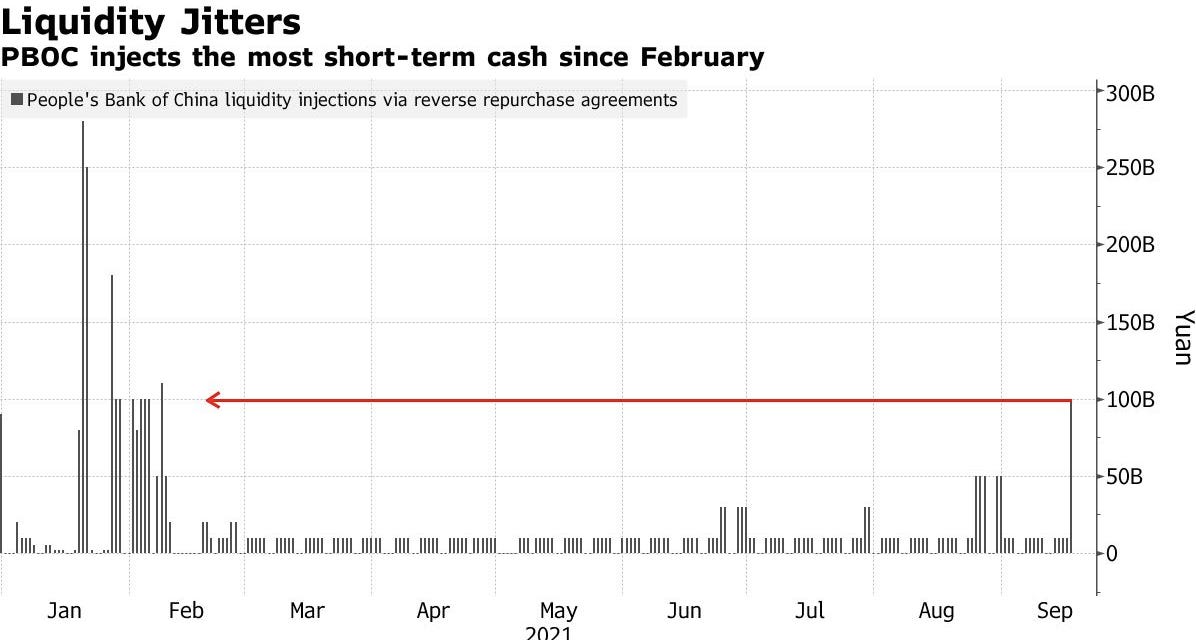The Daily Dive #063 - Evergrande Sparks Sell-Off
Evergrande Gets Worse
After covering the Evergrande Real Estate Group last week in Daily Dive #060, our biggest concerns were with increased contagion spread to the Chinese economy and global markets. Since then, we’ve seen a tidal wave of Chinese market sell-offs in the real estate sector, a rise in China bond yields and a larger S&P 500 correction unfolding at the same time. China junk bond yields continue to climb past their March 2020 highs at 14% plus, while the Hang Seng Index fell an additional 8.35% since September 7.
So far, the largest contagion spread impacts show up in China’s over-leveraged real estate sector with equity and bond sell-offs happening amongst other top property developers like Country Garden Holdings and Sunac China Holdings. The next level of contagion spread would show up in the Chinese banking sector amidst a liquidity crunch. On Friday, The People’s Bank of China injected 90 billion yuan ($14 billion) of funds, the most since February, to provide short-term liquidity into the banking system.


Shares of Sinic Holdings Group Company, a Shanghai-based real estate developer, plunged nearly 90% on massive volumes (approximately 14 times above average trading volume) before trading was halted. In an article published by Bloomberg, Philip Tse, director and head of Hong Kong and China property research at Bocom International Holdings Co Ltd. said the following,
“‘It’s the same story as everywhere else -- investors are concerned about the liquidity. I think there are most likely some margin calls on some of the major shareholders,’ by looking at Sinic’s stock price pattern this afternoon.”
S&P 500 Faces 100-Day MA Test
Before today, the S&P 500 had been holding above its 50-day moving average (and 100-day MA) since November, 2020. In the face of a larger correction kicking off over the last year, the S&P 500 has bounced to new highs each time. With over 100% returns since the pandemic bottom on the backs of inflating asset prices from federal stimulus, a major correction has been overdue. The index is now facing a critical test of the 100-day MA as more investors take defensive stances with a rise of bearish sentiment in the market.
We can look at the VIX, which generates a 30-day forward projection of S&P 500 index volatility, to gauge market expectations. At its new peak of 27.93 (and growing as we write this) since four months ago in May, it’s forecasting a higher risk-environment with more fear starting to kick in.
A larger macro correction in the S&P 500 and broader global markets has been the most significant risk to slowing bitcoin’s Q4 double-bull cycle. Almost every bitcoin correction in 2021 has correlated with an S&P 500 correction. Although little has changed in bitcoin’s bullish on-chain supply dynamics indicating a bigger move coming, short-term bitcoin price is at the whim of a much larger market move.
Back in The Deep Dive May Monthly Report we said the following in regards to equity market volatility and potential sell offs in legacy financial markets,
“Investors looking for attractive entry points to the bitcoin market should keep a very close eye on credit markets and the VIX into the future. Global financial markets are entirely dependent on central bank easing and balance sheet expansion to keep markets “functioning correctly.”
“Certain securities in the treasury market, the most liquid market in the world, went no bid for a stretch during the March crash, as liquidity completely dried up across the financial sector.
“Bitcoin wicked to $3,800, and was declared a “failing” safe-haven asset.
“Yet, there remains a real difference in how an asset performs during a liquidity crisis and how it might perform as a safe haven from monetary expansion. Bitcoin, at this point, is the latter, and as it continues to gain market share and liquidity in global financial markets, it will likely act as a pure price signal for the credit expansion or contraction occurring in the legacy system.
“While it cannot be known when the next liquidity crises will arise, the problems that arose during the Great Financial Crisis in 2008 and in March 2020 have only been made worse. We expect another large deleveraging event to occur as the everything bubble fueled by QE infinity and Modern Monetary Theory continues to increase debt levels and inflate asset prices.
“There will be another liquidity crisis, and volatility will absolutely explode. A certain class of bitcoiners will embrace this event and happily continue to accumulate and HODL.
“For those that are worried about sharp drawdowns into the future, consider longing VOL with a small allocation of your portfolio. This could help limit some upside during the parabolic uptrends as liquidity from quantitative easing programs flow into bitcoin. The asymmetry of a long volatility position will limit downside risk and allow hedged investors to buy the dip with a larger proportion of their portfolio.”
Asset Correlations Trending Towards 1.0
If this is truly the start of a major equity market correction, further weakness can be expected in not only equities and bitcoin, but across all asset classes. With the global economic system this over indebted, a sharp sell-off in financial markets will quickly spark a fire sale across markets, and asset correlations will spike to 1.0. A simple way to think of this is the dollar getting “bid” as tightening financial conditions lead to falling asset prices, increasing market liquidity, and falling collateral values in a reflexive cycle.

We will be monitoring the situation closely in The Deep Dive over the following days, weeks, and possibly even months. The macroeconomic environment is unequivocally intertwined with the adoption and price of bitcoin for the time being, and thus the Deep Dive will cover said developments accordingly.











